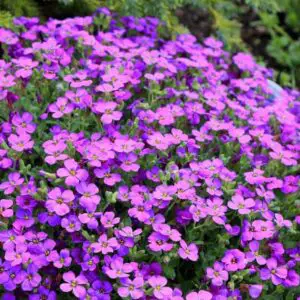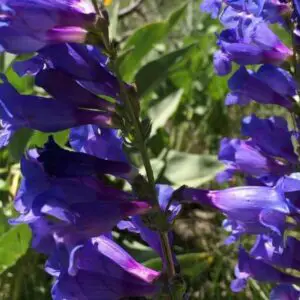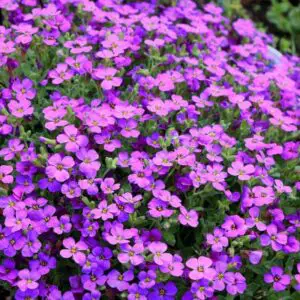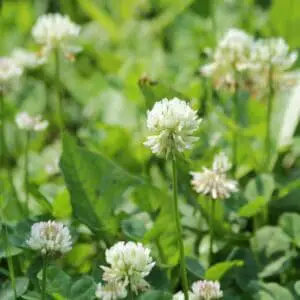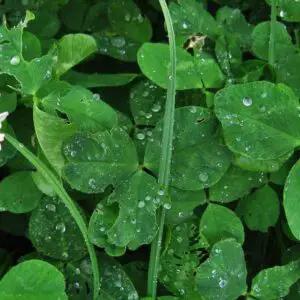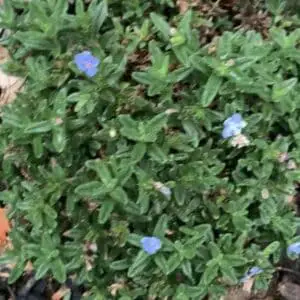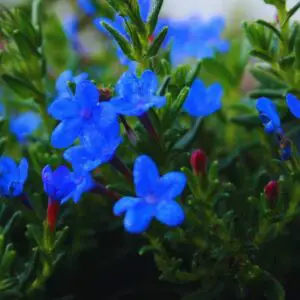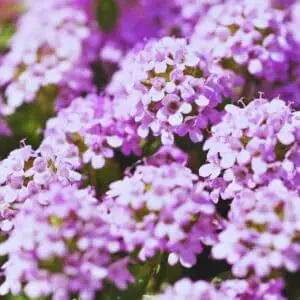Creeping phlox vs creeping thyme? This is a popular comparison a lot of people want to see. Both of these plants are low growers and make great ground covers. And top of that, they are easy to grow and require low maintenance.
Click here to see all posts about flowers.
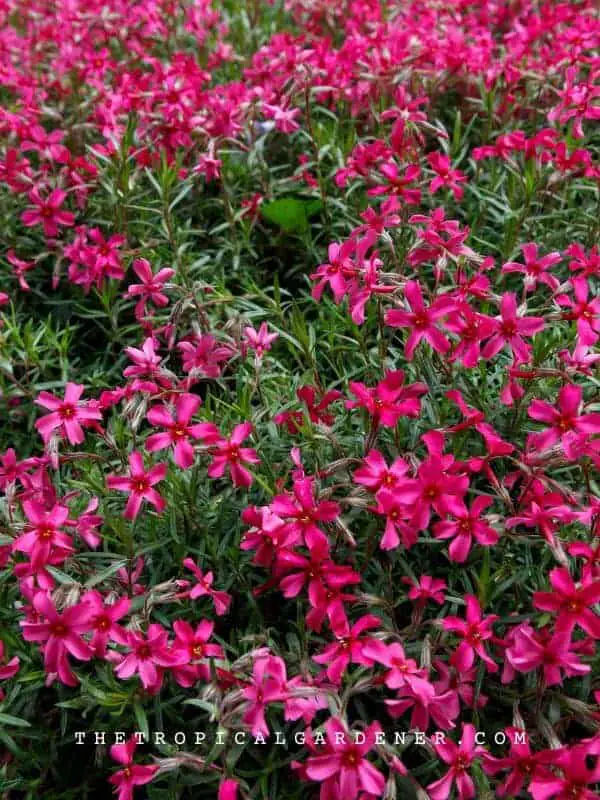
Table of Contents
Creeping Phlox vs Creeping Thyme: Quick facts
| Phlox | Thyme | |
| Origin | Eastern USA | Europe & N. Africa |
| Season | Summer | Summer |
| Winter Hardy | No | No |
| USDA Zone | 5 – 9 | 2 – 9 |
| Plant type | Perennial | Perennial |
| Bloom time | Spring / Summer | Summer |
| Sun | Full Sun | Full Sun |
| Soil | Loamy soil | Sandy soil |
| Soil PH | Acidic / Neutral / Alkaline | Neutral / Alkaline |
| Toxicity | Non-toxic | Non-toxic |
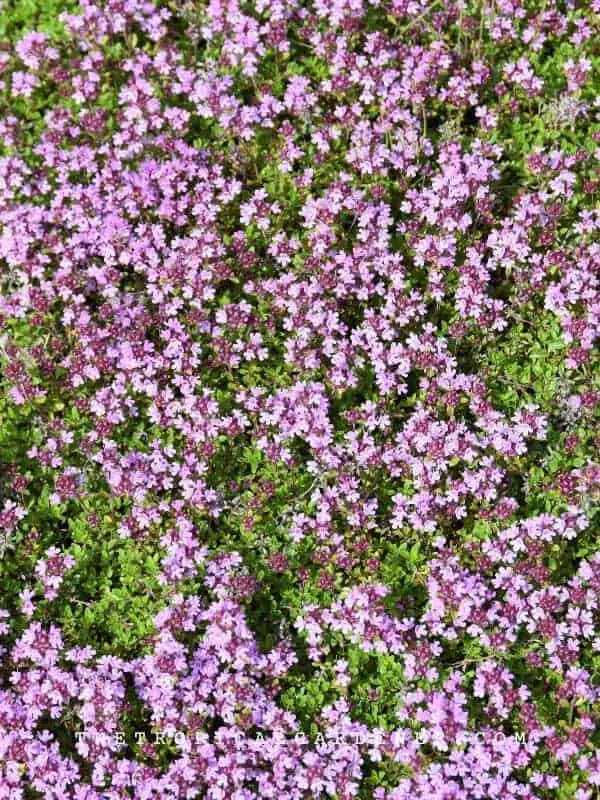
Before getting into the detailed comparison, here are some of the common questions people ask all the time about thyme and phlox.
Is creeping thyme and creeping phlox the same?
No, creeping thyme and creeping phlox are not the same plants. Even though they look the same, they belong to two different plant families. Creeping thyme is a plant, that belongs to the mint family (Lamiaceae) and creeping phlox belongs to the Polemoniaceae family.
Creeping thyme is also known as Breckland thyme, wild thyme, or elfin thyme. Creeping thyme is a common name that is used to refer to several similar-looking species. This is a close relative to the known herb thyme and most of them can be used in cooking too. All the thyme species including creeping thyme have a pleasant smell.
Creeping phlox is also a good ground cover just like creeping thyme. Phlox flowers also have a nice smell. However, creeping phlox is usually not used as a herb even though they are non-toxic.
Which is better creeping thyme or creeping phlox?
The answer is both. Both creeping thyme and creeping phlox are good plants to use as ground covers. Choosing one over the other depends on a few factors.
Creeping thyme grows a little shorter than creeping phlox (2-6 vs 6-12 inches or 5-15 vs 15-30 cm). So, if you want a shorter ground cover, you have to use creeping thyme.
The soil they grow in also matters. Creeping thyme likes well-draining, sandy, or rocky soil. However, creeping phlox do well in well-draining loamy soil which is rich in organic matter such as compost. Drainage matters a lot for thyme. They do not like being in wet soggy soil. So, plant thyme if you have well-draining sandy soil. Plant phlox if you have good soil, rich in nutrients.
Also, creeping thyme generally needs low maintenance than creeping phlox.
In conclusion, creeping thyme wins the battle between the two.
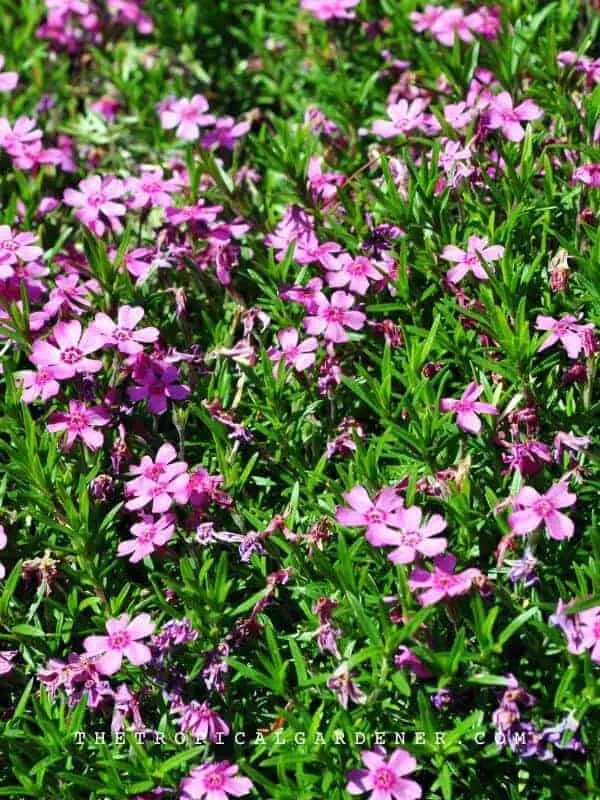
Can you plant creeping phlox and creeping thyme together?
It is not recommended to plant creeping phlox and creeping thyme together.
Both plants are very similar but they have different requirements to grow and flower.
The soil should be well draining for both plants, especially for thyme. Creeping thyme likes sandy and rocky soil. Creeping phlox likes nutrient-rich loamy soil. If you plant thyme with phlox in loamy soil, phlox is going to grow and thrive, while thyme is going to die slowly or vice versa.
And also the height of the plants matters too. Creeping phlox is taller than creeping thyme. So, phlox is going to grow over the thyme covering it. Thyme won’t have enough sunlight and it is going to die. After some time, you will see that the thyme has disappeared and phlox is taking over everything.
Differences between creeping thyme and creeping phlox
There are a few main differences between creeping thyme and creeping phlox.
| Creeping Thyme | Creeping Phlox |
| 2-6 inches tall | 6-12 inches tall |
| Clusters of small flowers about 1/2 inch in diameter | Larger flowers with five petals about 1 inch in diameter |
| Used as a herb in cooking | Not used in cooking |
| Needs full sun | Can tolerate some shade |
| Prefer sandy soil | Prefer loamy soil |
| Do not like high humidity | Tolerate high humidity |
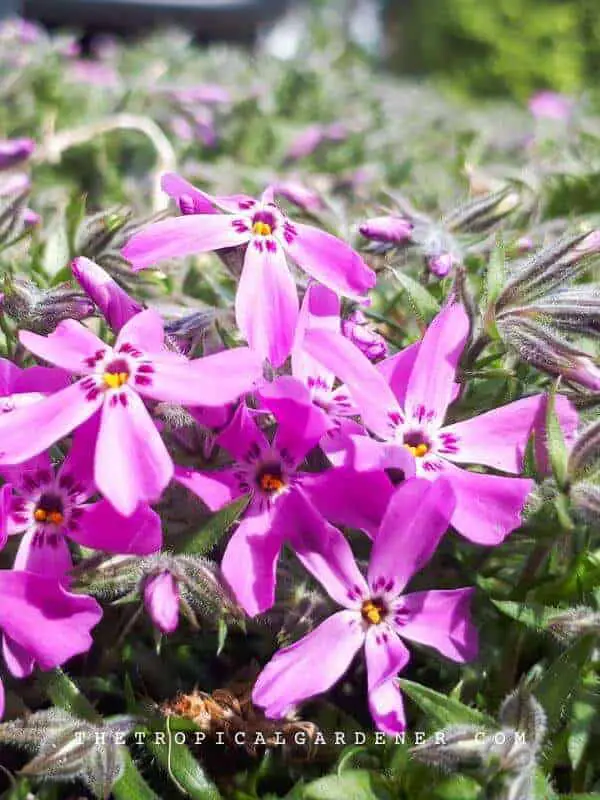
Detailed comparison
Origin
Creeping thyme
Creeping thyme is native to Europe and North Africa (Palearctic realm). It can be found growing on roadsides, river sandbanks, and rocky hills.
Creeping Phlox
Creeping phlox is native to the Eastern United States. It is spread in woodlands and stream banks from Pennsylvania to Northern Georgia.
Flowers
Creeping thyme
Creeping thyme has clusters of small flowers, usually 1/2 inch in diameter. They have a very pleasant balsamic or citrus scent. Flowers can be found in white, purple, and pink.
Creeping thyme starts flowering in spring or summer and will last for three to four weeks. Deadheading is not needed for continuous bloom.
Creeping phlox
Creeping phlox also has clusters of flowers but they are much larger than thyme. Usually around one inch in diameter. And has five petals.
Flowering starts around late spring or early summer. It will last for a few weeks. Deadheading is not needed just like creeping thyme.
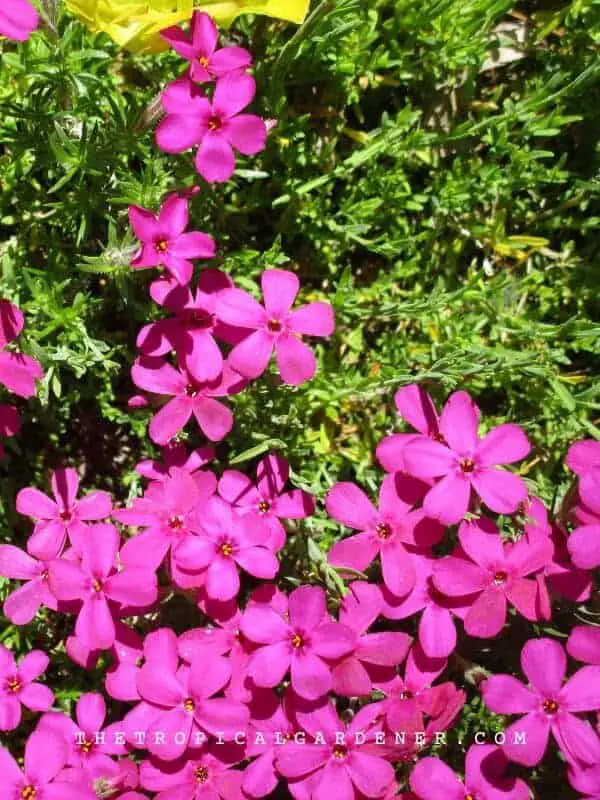
Growing conditions
Sun
Both plants require direct sunlight for at least 6 hours a day. Creeping phlox can tolerate partial shade. But for best results, try to plant in a sunny spot.
Soil
Drainage is very important for both plants, especially creeping thyme. They do not like soggy wet soil. They tend to have problems like root rot or yellowing leaves if the soil keeps wet.
Plant creeping thyme in sandy or rocky soil which is not nutrient rich. Do not add lots of compost or organic matter, just a little bit is okay if the soil is really poor.
Creeping phlox likes loamy soil which is rich with organic matter. So, add compost or animal manure before planting. This will also reduce the fertilizer you have to put in.
Water
Both plants like moist soil. If the soil drains quickly, frequent watering will be required. This is a common problem for creeping thyme.
Don’t let the soil dry out when the plants are young. You can reduce watering when they are established well.
If planted in pots or containers, daily watering will be required as the soil in pots dries out quicker than the ground.
Temperature
Both creeping thyme and creeping phlox like higher temperatures. They thrive in the summer heat.
Creeping thyme will die back for the most part in winter. However, it will still have some green parts and stems. You can apply 2 to 3 inches of mulch layer on top of it to keep the soil temperature high.
Creeping phlox can handle some frosts but will die back when the temperature drops significantly in winter.
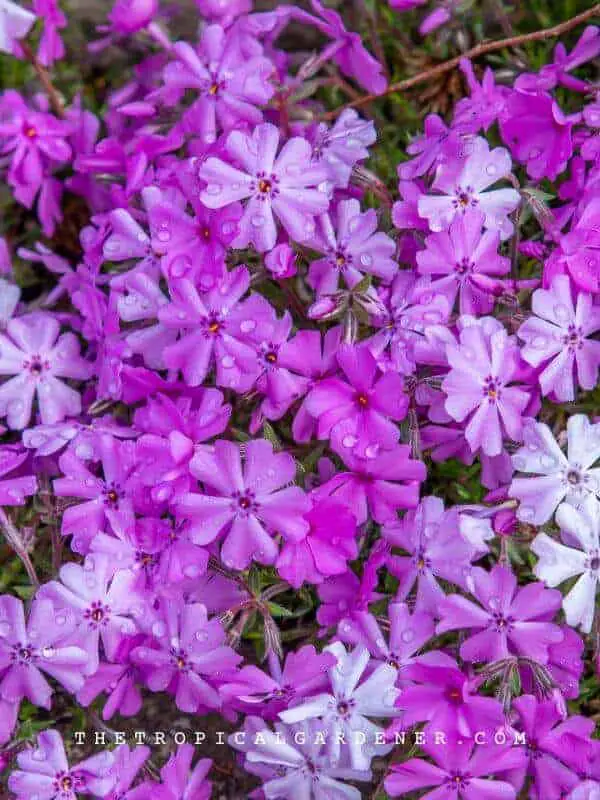
Propagation
Creeping thyme
Creeping thyme is best grown from seeds. It is a prolific self-seeder, so you will tiny seedlings popping up underneath the mature plants. Stems and division can also be used to propagate thyme. These options will give you more mature plants.
Creeping phlox
The division is the best way to propagate creeping phlox. Division can give you mature plants. You can divide a plant once every two to three years. Dividing too much can weaken and damage the mother plant, so be mindful not to divide too much.
Seeds can also be used to grow new phlox plants. But it is a slow and difficult process. So, it is not recommended unless you have plenty of patience. 🙂
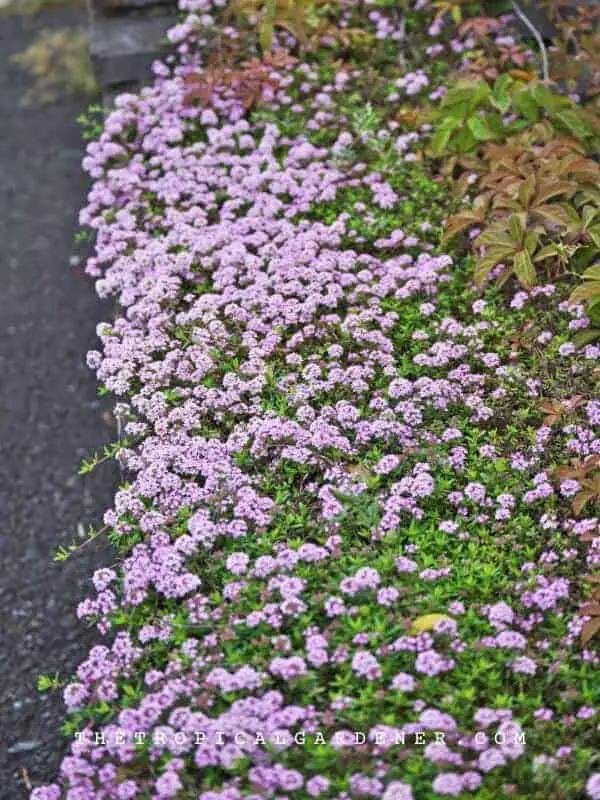
Pests and diseases
Creeping thyme
Spider mites and aphides can sometimes attack creeping thyme. DIY soap insecticide is good enough to handle those bugs. You can also use the garden hose to spray those bugs off the plants.
Root rot can occur in wet soggy soil. This is a common problem when the drainage is bad. Increasing drainage is the best option. Mix sand to the soil and spread gravel or sand around the plant to stop it from touching the wet soil.
Creeping phlox
Creeping phlox also suffer from spider mite attacks. You can use the same methods described above to get rid of them.
Foliar nematodes can also be a problem for phlox in wet and humid conditions. They will damage leaves which will become brown and then turn black. These nematodes live in soil and are very difficult to control. So, it is important to remove the entire plant and throw it away.
Yellowing leaves are also common in both plants. Overwatering and not enough sunlight are the main reasons for this. Increasing drainage and reducing watering can help. Also, give them plenty of sunlight.
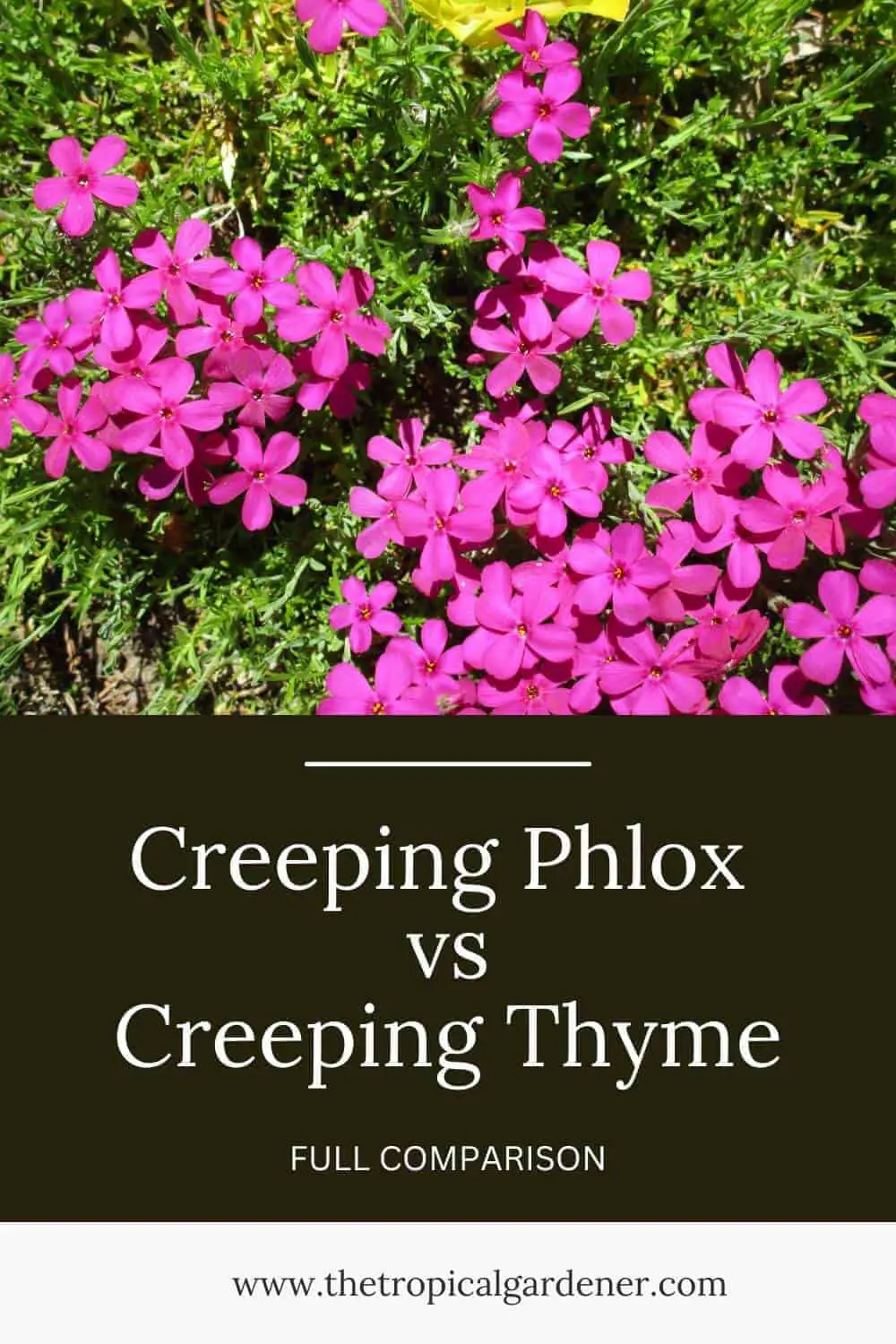
Last update on 2024-05-06 / Affiliate links / Images from Amazon Product Advertising API






